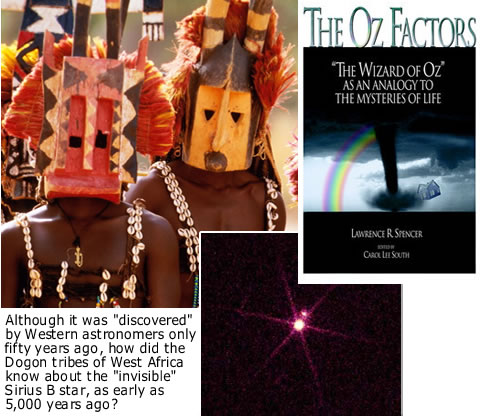Republished by Blog Post Promoter

ASTRONOMY IS “SIRIUS” BUSINESS
“… meet the young lady who fell from a star. She fell from the sky, she fell very far and Kansas, she says, is the name of the star …” – Glinda in ‘The Wizard of Oz’
As an Egyptian child 3,000 years ago, you might have asked your mother, “Mommy, where did I come from?” She may have replied, “Well, dear, I think it was from Orion’s Belt.
According to hieroglyphic records, the stars of Orion’s Belt were the symbolic analogy to the “phallus” of the constellation of Orion upon which his sister/wife Isis (the star Sirius) would “rise above Orion” in the sky and “impregnate” herself. The union of these two constellations, gave birth to their “son”, the Egyptian god Horus, the seventh “Divine Ruler” of Egypt.
Celestial orientation was the Egyptian common denominator to an understanding of the Egyptian viewpoint of life on Earth, and life after death.
The Egyptian priesthood worshipped the stars. The comings and goings of the gods were monitored by the stars. The calendar of days, holidays, festivals and harvests were determined by the stars. The rising of the star Sirius, also called the “Dog Star” because of its prominent position in the constellation of Canis Major, marked the beginning of the new year and is the entire basis for the Easter celebration as adopted by the Christians centuries after the fall of Egypt. The movements of the star Sirius monitored the entire Egyptian calendar.
MYSTERIOUS SIRIUS
Sirius is actually a double star system. One of the stars is the brightest star in the sky visible from Earth. The other is a dark star, an extremely dense and heavy star, which is entirely invisible to the naked eye. (One teaspoon of matter from this star might weigh thousands of pounds on Earth). The dark star was not detected for the first time until 1970.
The triple star system of Sirius gained international notoriety during the late 1960s. Though never photographed until 1970, the dark star of Sirius was made known to a team of French anthropologists by a remote tribe living near Timbuktu in Northern Africa called the Dogon. The religious leaders of the Dogon knew all about these stars, including, mysteriously:
1/ The exact 50 year repeating pattern of the elliptical orbit of Sirius “B” around Sirius “A”.
2/ Patterns of orbital motion relative to each other (one star periodically blocks the view of the other as they revolve).
3/ The extremely small size, the tremendously dense and heavy mass and invisibility of Sirius “B”.
4/ The existence of the red dwarf star, Sirius “C”, which was not observed for the first time by modern astronomers until 1995.
5/ For more than a thousand years, the Dogon also knew about four other “invisible” bodies in our own solar system; namely, the four major moons of Jupiter which were not acknowledged in Western civilization until Galileo discovered them with his version of the telescope which had been invented the previous year, in 1608, by Hans Lippershey.
A DOGON SIRIUS MYSTERY
How could an obscure tribe of technically backward, uneducated people know so many factual details about a star system of which Western astronomers knew almost nothing?
This relatively primitive tribe of black Africans claimed that their ancestors were priests who had been driven out of Egypt in the very distant past. The secrets of these priests were closely held among the elders of their tribe. They claim that a race of beings with aquatic characteristics descended from a planet in the star system of Sirius. These being were called the “Nomos”. These beings are reported to have brought civilization to Earth about 5,000 years ago and then returned to the Sirius system. The Dogon say that the Nomos will return to Earth. The Dogon say that the detailed information they possess about the Sirius star system was given to them about 5,000 years ago by the beings who came to Earth from Sirius.
The scientific, cultural, religious, mythological, astronomical and anthropological implications of the knowledge of the Dogon, and of the tremendous significance placed on Sirius by the Egyptian priests, is marvelously documented in the fascinating book by Robert K G Temple entitled, ‘The Sirius Mystery’. This book has inspired other innovative investigators to pick up the trail of the investigation into what was REALLY going on in ancient Egypt.
Egyptology has fascinated scholars and captured popular imagination for thousands of years. Why? Simply because it has been so mysterious! Subjects that are easily investigated and understood rarely command much attention. And, there are few subjects as full of hidden meanings, esoteric innuendo and misleading anomalies as the hieroglyphic texts and architectural monuments of Egypt.
Despite decades of investigation, the theoretical posturing of Egyptologists have left many of the very basic elements of its mysteries unanswered. For example:
1/ What secret information did the priests of Isis and Osiris NOT share with the uninitiated layman?
2/ What knowledge did the priests and pharaohs possess, which empowered them with control over not only the affairs of state, but the wealth of the richest treasury in the world?
3/ Were the priests hiding something from the rest of the world?
Just as modern Western intelligence agencies have controlled knowledge to protect their special vested interests over the last thousand years, so did the priests of ancient Egypt.
The secret order of priests in Egypt possessed a very, very sophisticated knowledge of mathematics, architecture and astronomy, among other esoteric studies. In fact, most of the rest of the world learned almost everything they knew from Egypt, with the possible exception of the Sumerians, who had already built their own pyramid civilization before the Egyptians ever got started.
_________________________
Excerpt from THE OZ FACTORS, by Lawrence R. Spencer





